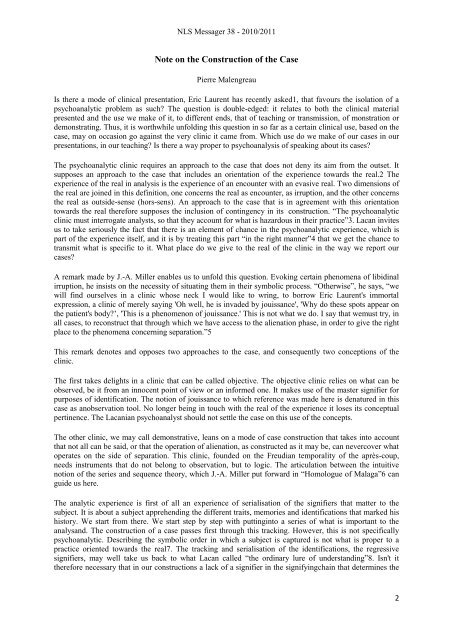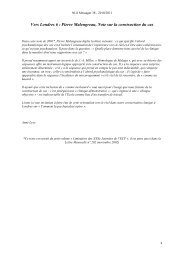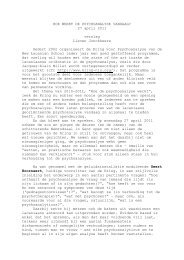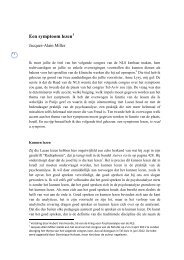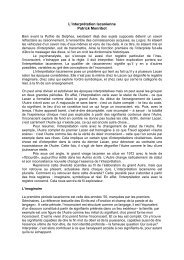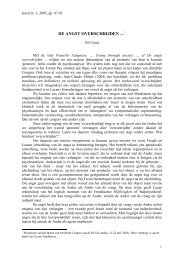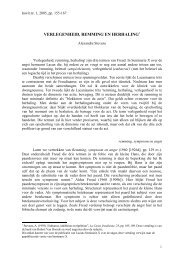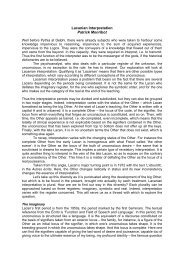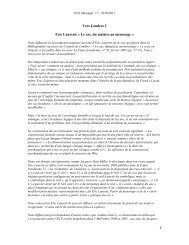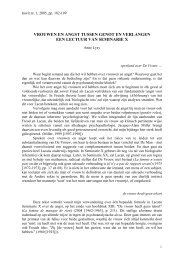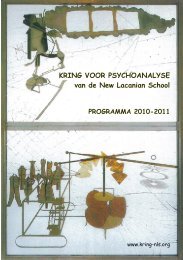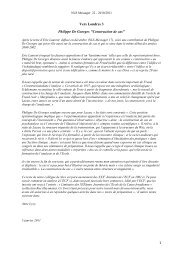Pierre Malengreau, Note on the Construction of the Case
Pierre Malengreau, Note on the Construction of the Case
Pierre Malengreau, Note on the Construction of the Case
You also want an ePaper? Increase the reach of your titles
YUMPU automatically turns print PDFs into web optimized ePapers that Google loves.
NLS Messager 38 - 2010/2011<br />
<str<strong>on</strong>g>Note</str<strong>on</strong>g> <strong>on</strong> <strong>the</strong> C<strong>on</strong>structi<strong>on</strong> <strong>of</strong> <strong>the</strong> <strong>Case</strong><br />
<str<strong>on</strong>g>Pierre</str<strong>on</strong>g> <str<strong>on</strong>g>Malengreau</str<strong>on</strong>g><br />
Is <strong>the</strong>re a mode <strong>of</strong> clinical presentati<strong>on</strong>, Eric Laurent has recently asked1, that favours <strong>the</strong> isolati<strong>on</strong> <strong>of</strong> a<br />
psychoanalytic problem as such? The questi<strong>on</strong> is double-edged: it relates to both <strong>the</strong> clinical material<br />
presented and <strong>the</strong> use we make <strong>of</strong> it, to different ends, that <strong>of</strong> teaching or transmissi<strong>on</strong>, <strong>of</strong> m<strong>on</strong>strati<strong>on</strong> or<br />
dem<strong>on</strong>strating. Thus, it is worthwhile unfolding this questi<strong>on</strong> in so far as a certain clinical use, based <strong>on</strong> <strong>the</strong><br />
case, may <strong>on</strong> occasi<strong>on</strong> go against <strong>the</strong> very clinic it came from. Which use do we make <strong>of</strong> our cases in our<br />
presentati<strong>on</strong>s, in our teaching? Is <strong>the</strong>re a way proper to psychoanalysis <strong>of</strong> speaking about its cases?<br />
The psychoanalytic clinic requires an approach to <strong>the</strong> case that does not deny its aim from <strong>the</strong> outset. It<br />
supposes an approach to <strong>the</strong> case that includes an orientati<strong>on</strong> <strong>of</strong> <strong>the</strong> experience towards <strong>the</strong> real.2 The<br />
experience <strong>of</strong> <strong>the</strong> real in analysis is <strong>the</strong> experience <strong>of</strong> an encounter with an evasive real. Two dimensi<strong>on</strong>s <strong>of</strong><br />
<strong>the</strong> real are joined in this definiti<strong>on</strong>, <strong>on</strong>e c<strong>on</strong>cerns <strong>the</strong> real as encounter, as irrupti<strong>on</strong>, and <strong>the</strong> o<strong>the</strong>r c<strong>on</strong>cerns<br />
<strong>the</strong> real as outside-sense (hors-sens). An approach to <strong>the</strong> case that is in agreement with this orientati<strong>on</strong><br />
towards <strong>the</strong> real <strong>the</strong>refore supposes <strong>the</strong> inclusi<strong>on</strong> <strong>of</strong> c<strong>on</strong>tingency in its c<strong>on</strong>structi<strong>on</strong>. “The psychoanalytic<br />
clinic must interrogate analysts, so that <strong>the</strong>y account for what is hazardous in <strong>the</strong>ir practice”3. Lacan invites<br />
us to take seriously <strong>the</strong> fact that <strong>the</strong>re is an element <strong>of</strong> chance in <strong>the</strong> psychoanalytic experience, which is<br />
part <strong>of</strong> <strong>the</strong> experience itself, and it is by treating this part “in <strong>the</strong> right manner”4 that we get <strong>the</strong> chance to<br />
transmit what is specific to it. What place do we give to <strong>the</strong> real <strong>of</strong> <strong>the</strong> clinic in <strong>the</strong> way we report our<br />
cases?<br />
A remark made by J.-A. Miller enables us to unfold this questi<strong>on</strong>. Evoking certain phenomena <strong>of</strong> libidinal<br />
irrupti<strong>on</strong>, he insists <strong>on</strong> <strong>the</strong> necessity <strong>of</strong> situating <strong>the</strong>m in <strong>the</strong>ir symbolic process. “O<strong>the</strong>rwise”, he says, “we<br />
will find ourselves in a clinic whose neck I would like to wring, to borrow Eric Laurent's immortal<br />
expressi<strong>on</strong>, a clinic <strong>of</strong> merely saying 'Oh well, he is invaded by jouissance', 'Why do <strong>the</strong>se spots appear <strong>on</strong><br />
<strong>the</strong> patient's body?’, 'This is a phenomen<strong>on</strong> <strong>of</strong> jouissance.' This is not what we do. I say that wemust try, in<br />
all cases, to rec<strong>on</strong>struct that through which we have access to <strong>the</strong> alienati<strong>on</strong> phase, in order to give <strong>the</strong> right<br />
place to <strong>the</strong> phenomena c<strong>on</strong>cerning separati<strong>on</strong>.”5<br />
This remark denotes and opposes two approaches to <strong>the</strong> case, and c<strong>on</strong>sequently two c<strong>on</strong>cepti<strong>on</strong>s <strong>of</strong> <strong>the</strong><br />
clinic.<br />
The first takes delights in a clinic that can be called objective. The objective clinic relies <strong>on</strong> what can be<br />
observed, be it from an innocent point <strong>of</strong> view or an informed <strong>on</strong>e. It makes use <strong>of</strong> <strong>the</strong> master signifier for<br />
purposes <strong>of</strong> identificati<strong>on</strong>. The noti<strong>on</strong> <strong>of</strong> jouissance to which reference was made here is denatured in this<br />
case as anobservati<strong>on</strong> tool. No l<strong>on</strong>ger being in touch with <strong>the</strong> real <strong>of</strong> <strong>the</strong> experience it loses its c<strong>on</strong>ceptual<br />
pertinence. The Lacanian psychoanalyst should not settle <strong>the</strong> case <strong>on</strong> this use <strong>of</strong> <strong>the</strong> c<strong>on</strong>cepts.<br />
The o<strong>the</strong>r clinic, we may call dem<strong>on</strong>strative, leans <strong>on</strong> a mode <strong>of</strong> case c<strong>on</strong>structi<strong>on</strong> that takes into account<br />
that not all can be said, or that <strong>the</strong> operati<strong>on</strong> <strong>of</strong> alienati<strong>on</strong>, as c<strong>on</strong>structed as it may be, can nevercover what<br />
operates <strong>on</strong> <strong>the</strong> side <strong>of</strong> separati<strong>on</strong>. This clinic, founded <strong>on</strong> <strong>the</strong> Freudian temporality <strong>of</strong> <strong>the</strong> après-coup,<br />
needs instruments that do not bel<strong>on</strong>g to observati<strong>on</strong>, but to logic. The articulati<strong>on</strong> between <strong>the</strong> intuitive<br />
noti<strong>on</strong> <strong>of</strong> <strong>the</strong> series and sequence <strong>the</strong>ory, which J.-A. Miller put forward in “Homologue <strong>of</strong> Malaga”6 can<br />
guide us here.<br />
The analytic experience is first <strong>of</strong> all an experience <strong>of</strong> serialisati<strong>on</strong> <strong>of</strong> <strong>the</strong> signifiers that matter to <strong>the</strong><br />
subject. It is about a subject apprehending <strong>the</strong> different traits, memories and identificati<strong>on</strong>s that marked his<br />
history. We start from <strong>the</strong>re. We start step by step with puttinginto a series <strong>of</strong> what is important to <strong>the</strong><br />
analysand. The c<strong>on</strong>structi<strong>on</strong> <strong>of</strong> a case passes first through this tracking. However, this is not specifically<br />
psychoanalytic. Describing <strong>the</strong> symbolic order in which a subject is captured is not what is proper to a<br />
practice oriented towards <strong>the</strong> real7. The tracking and serialisati<strong>on</strong> <strong>of</strong> <strong>the</strong> identificati<strong>on</strong>s, <strong>the</strong> regressive<br />
signifiers, may well take us back to what Lacan called “<strong>the</strong> ordinary lure <strong>of</strong> understanding”8. Isn't it<br />
<strong>the</strong>refore necessary that in our c<strong>on</strong>structi<strong>on</strong>s a lack <strong>of</strong> a signifier in <strong>the</strong> signifyingchain that determines <strong>the</strong><br />
2


